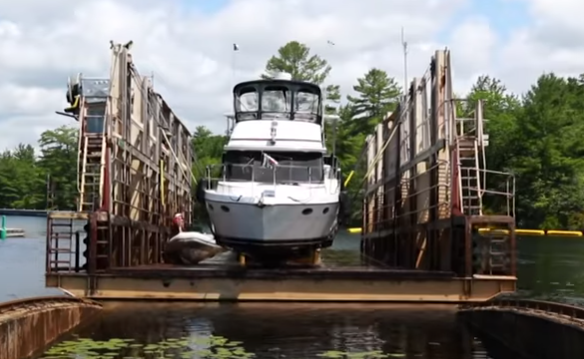Flowing between some of Ontario’s 250,000 lakes runs a marvel of human ingenuity.
The Trent-Severn Waterway spans nearly 400 kilometres; wide rivers swoop around Canadian Shield and pines and spruce trees line pristine lake shores.
It's a boating destination with North America-wide fame.
And northern Simcoe County plays a special role in any boater’s (or interested sight-seer’s) journey through one of the world’s most scenic waterways.
That’s because it’s the only place in North America where boaters hop on a train — and bring their boat along for the ride over the Canadian Shield.
The Big Chute Marine Railway, just a 20-minute drive from Coldwater, is the only one of its kind in North America.
The massive feat of engineering carries boats 228 metres up and over Canadian Shield between the Severn River and Gloucester Pool over two sets of wheel tracks and an advanced pulley system.
And this weekend kicks off the marine railway’s busy season; the pulleys and gears oiled, the water on either side filled with boaters soaking up the sun.
But what’s become one of our largest tourism attractions has roots which reach far deeper, to before yachts and pleasure crafts traversed our waterways; when the waterway was a remote destination far from the fledgling town of Orillia.
The waterways in our area were used to transport everything from food to lumber to the remote communities in what’s now known as Simcoe County - an area far from the bustle of ever-growing Toronto.
“Either you worked in a lumber company or you were farming,” says Simcoe North MP Bruce Stanton, who has a family connection to the Big Chute area.
'Big Chute' refers to the water flowing into Georgian Bay from the lakes in the area: water which was used to power hydroelectric dams which were vital in keeping Orillia’s lights on.
Stanon's family settled in Sparrow lake in the early 1880s. That’s a small lake north of Couchiching which funnels water over the Swift Rapids and toward Lock 44; the marine railway.
While the Trent-Severn waterway was completed in 1920, the marine railway was finished in 1917 — a vital piece in the long journey between small towns in the area.
“It’s such a unique feature — they had to expand it into a bigger marine railway operation — and they didn’t have much to draw on,” says Stanton.
The Marine Railway you can traverse today was built in 1978; engineered to carry boats up to 100 feet long — and keep them level with a much-celebrated dual track system.
But the engineers designing both railways didn’t have similar water-to-water railway systems to go off.
That’s a departure from the first railway, which was a bit more rollercoaster-inspired.
“It was a little more nerve-wracking,” says Stanton with a laugh.
That much smaller marine railway still sits beside the one in current use.
It's a larger and smoother railway system these days - perhaps a less thrilling ride. “It’s a lot more plain than you think,” Stanton says.
The railway also played a key part in tackling marine stow-aways.
Sea Lamprey, an invasive species of blood-sucking eels, spread into the great lakes waterways like wildfire.
The marine railway acted like a fire wall. In fact, in the early days, after Lamprey were found in the Gloucester pool, biologists found the creatures fell off ships travelling up the railway — playing a small part in protecting fish populations further upstream.
However now, more than 40 years after the marine railway was built, it’s used almost exclusively for recreational traffic.
It’s a bucket list item for many North American boat-trip enthusiasts. “The Great Loop” is a 6,000 mile boat journey around U.S and Canada’s Great Lakes: the chute features in many “loopers” blogs and videos — a highlight of the trip.
In fact, according to staff at the lock, it’s one of the top three most-travelled locks in the Trent-Severn waterway system.
A nearby parking lot allows visitors to check out the famed passage— steps lead down to tranquil waters at the base of the railway where, on busy days, boats line up to wait their turn to voyage up and over the railway, and onward toward lake Couchiching.
While the railway is rooted in Trent-Severn’s early history, it’s now a piece of living history for boaters and day-trippers alike to enjoy.
